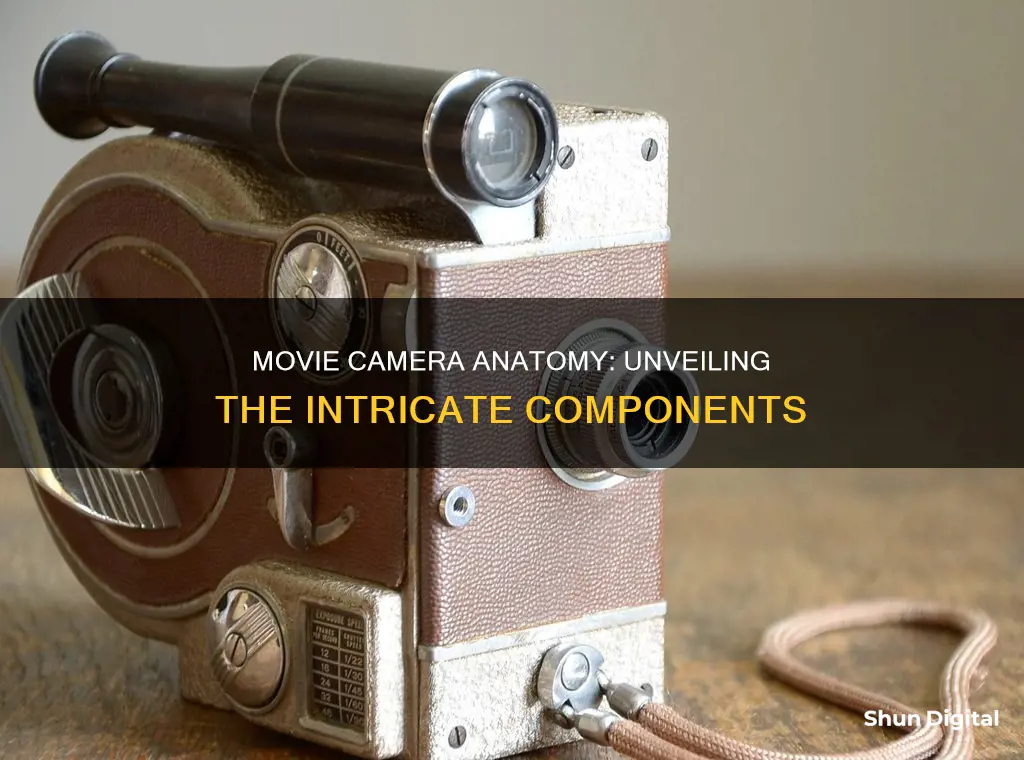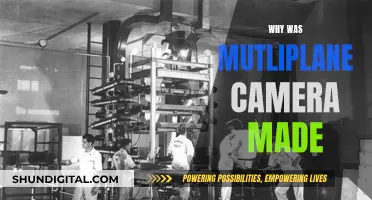
A movie camera, also known as a film camera or cine-camera, is a type of photographic camera that takes a rapid sequence of photographs on film stock or an image sensor. The body of a movie camera is made of various parts, including a film-transport system, lenses, a shutter, and a viewing-focusing system. The film used in these cameras is typically made of a transparent film base coated with a gelatin emulsion containing light-sensitive silver halide crystals. The size and characteristics of these crystals determine the film's sensitivity, contrast, and resolution.
| Characteristics | Values |
|---|---|
| Type of camera | Photographic camera, film camera, cine-camera, movie camera |
| Function | Takes a rapid sequence of photographs to produce a moving image |
| Image capture | Onto film stock or an image sensor |
| Frame rate | 24 frames per second or more |
| Parts | Optical element (lens), chemical element (film), mechanical element (camera body) |
| Frame size | 8mm, 16mm, 35mm, 70mm |
| Frame format | Standard 8, 16mm, 35mm |
| Film type | Photographic film, colour film, black-and-white film, digital |
| Film composition | Transparent film base, gelatin emulsion, light-sensitive silver halide crystals |
| Film speed | ISO 25, 50, 64, 100, 160, 200, 400, 800, 1600 |
What You'll Learn

Camera lenses
The focal length of a lens, usually measured in millimetres, refers to its magnification power. A longer focal length means higher magnification, while a shorter focal length means lower magnification. For example, a lens with a focal length of 24mm will offer less magnification than a lens with a focal length of 200mm.
There are several types of camera lenses, each designed for different shooting scenarios:
- Zoom lenses offer a range of focal lengths, making them versatile and ideal for travelling photographers who don't want to carry multiple lenses.
- Prime lenses have a single focal length and do not allow the user to zoom in on the subject. However, they typically offer superior image quality due to having fewer lens elements and moving parts. They also have low aperture values, making them suitable for portraits and product photography, or any situation where a blurry background is desired.
- Telephoto lenses offer greater magnification for shooting subjects that are far away, such as wildlife or sports photography.
- Wide-angle lenses have smaller focal lengths and can capture a wider perspective, making them suitable for landscape, architecture, and interior photography.
- Macro lenses allow for extremely close-up shots, magnifying subjects such as insects, flowers, or small objects in extreme detail.
When choosing a camera lens, several factors need to be considered, including the desired focal length, lens speed, compatibility with the camera body, and budget. Additionally, different lenses have different features such as image stabilisation and silent autofocus.
The quality of a camera lens also plays a significant role in the resulting image quality. Higher-quality lenses are usually made with higher-grade glass elements, resulting in sharper and clearer images. They are also typically weather-sealed, making them more expensive.
Portait Mode on Galaxy S7 Edge: Where and How?
You may want to see also

Camera body
The camera body is the mechanical element of the camera. It is a sealed box with a shutter that opens and closes between the lens and the film. The camera body controls the film's exposure to light. The amount of light that passes through the lens is determined by the size of the aperture—the lens opening. The shutter speed also influences the length of exposure.
The camera body of a motion-picture camera is differentiated from a still camera by its motor-driven transport system. The unexposed film is housed in a totally dark chamber called the forward magazine. The film is then fed into an enclosed exposure chamber, where a mechanical claw pulls the film into position behind the shutter. After exposure, the claw advances the film for the next exposure.
In a single-lens-reflex (SLR) camera, the photographer sees the exact image that is exposed to the film and can adjust the settings by turning dials and clicking buttons. The camera body directs the real image to the viewfinder before a picture is taken and then to the film when the shutter button is pressed. A mirror diverts some of the light rays coming through the lens to the viewfinder. When the shutter button is pressed, the mirror flips up so the image is projected onto the film.
Moultre Camera: Uncovering Infrared Battery Secrets
You may want to see also

Film
The emulsion will gradually darken if left exposed to light, but the process is too slow and incomplete to be of any practical use. Instead, a very short exposure to the image formed by a camera lens is used to produce only a very slight chemical change, proportional to the amount of light absorbed by each crystal. This creates an invisible latent image in the emulsion, which can be chemically developed into a visible photograph.
In black-and-white photographic film, there is usually one layer of silver halide crystals. When the exposed silver halide grains are developed, the silver halide crystals are converted to metallic silver, which blocks light and appears as the black part of the film negative. Color film has at least three sensitive layers, incorporating different combinations of sensitizing dyes. Typically, the blue-sensitive layer is on top, followed by a yellow filter layer to stop any remaining blue light from affecting the layers below. Next comes a green-and-blue-sensitive layer, and a red-and-blue-sensitive layer, which record the green and red images, respectively. During development, the exposed silver halide crystals are converted to metallic silver, just as with black-and-white film. But in color film, the by-products of the development reaction simultaneously combine with chemicals known as color couplers to form colored dyes.
The gelatin emulsion that coats the film base is made by dissolving pure silver in nitric acid to form silver nitrate crystals, which are then mixed with other chemicals to form silver halide grains. These are suspended in gelatin and applied to the film base. The size and, hence, the light sensitivity of these grains determine the speed of the film. Each crystal is often 0.2 to 2 microns in size; in color films, the dye clouds that form around the silver halide crystals are often 25 microns across.
The film base was initially made of highly flammable cellulose nitrate but was replaced by cellulose acetate films, often cellulose triacetate film (safety film). This, in turn, was replaced in many films by a PET (polyethylene terephthalate) plastic film base.
The Evolution of Cameras: Step-by-Step Guide
You may want to see also

Shutter
In photography, a shutter is a device that allows light to pass for a specific duration, exposing the film or a photosensitive digital sensor to light, which captures a permanent image of a scene. Shutters can be fitted in several positions, and their speed is controlled either automatically by the camera or manually through digital settings.
Types of Shutters
Leaf Shutters
Leaf shutters are usually fitted within a lens assembly (central shutter) or, more rarely, immediately behind (behind-the-lens shutter) or in front of a lens, and they shut off the beam of light where it is narrow. The leaf shutter, positioned between or just behind the lens components, consists of several overlapping metal blades that are opened and closed either by spring action or electronically.
Focal-Plane Shutters
Focal-plane shutters are mounted near the focal plane and move to uncover the film or sensor. A focal-plane shutter is positioned just in front of the film, in the focal plane, and moves an aperture across the film until the full frame has been exposed. They are usually implemented as a pair of light-tight cloth, metal, or plastic curtains. The width of the slit determines the exposure time; the narrower the slit, the shorter the exposure.
The time for which a shutter remains open (exposure time, often called "shutter speed") is determined by a timing mechanism. Mechanical shutters typically had three settings: Time, where the shutter opened when the button was pressed and remained open until it was pressed again; Bulb, where the shutter remained open as long as the button was pressed; and Instantaneous exposure, with settings ranging from 30" to 1/4000" for the best leaf shutters, faster for focal-plane shutters, and more restricted for basic types. The reciprocal of exposure time in seconds is often used for engraving shutter settings. For example, a marking of "250" denotes 1/250".
Flash Synchronization
Most shutters have a flash synchronization switch to trigger a flash, if connected. This was quite complicated with mechanical shutters and flashbulbs, but the problems were essentially solved with the advent of electronic flash units, which fire virtually instantaneously and emit a very short flash. When using a focal-plane shutter with a flash, if the shutter is set at its X-sync speed or slower, the whole frame will be exposed when the flash fires; otherwise, only a band of the film will be exposed.
Stealth Trail Cameras: What Batteries Do They Use?
You may want to see also

Film-transport system
The film-transport system is the main element that differentiates a movie camera from a still camera. It is motor-driven and allows for the rapid capture of a sequence of photographs, which are then projected at a specific frame rate to produce a moving image.
The unexposed film is housed in a totally dark chamber called the forward magazine. One or both edges of the film are lined with regularly spaced perforations, or sprocket holes. Sprocket-driven gears grip these perforations, feeding the film into an enclosed exposure chamber. A mechanical claw then pulls the film into position behind the shutter, locking it momentarily in place.
The shutter opens, exposing an image onto the film, and then closes. The claw then advances the film for the next exposure with an automatic pulldown movement. Each frame of the film comes to a complete stop for its exposure, and each exposure is a single still photograph, or frame. As the film moves through the camera, the exposed sections are fed into the rear magazine, another totally dark chamber.
The standardised frame rate for commercial sound film is 24 frames per second.
Simplisafe Doorbell Camera: Charging Simplified
You may want to see also
Frequently asked questions
A movie camera is made up of three basic elements: an optical element (the lens), a chemical element (the film), and a mechanical element (the camera body itself).
The lens is the optical component of the camera. It is usually a curved piece of glass or plastic that redirects light bouncing off an object to form a real image.
The film is the chemical component of a movie camera. It is a strip or sheet of transparent film base coated with a gelatin emulsion containing light-sensitive silver halide crystals. When exposed to light, the film creates an invisible latent image, which can then be chemically developed into a visible photograph.
The camera body is the mechanical element of the movie camera. It houses the other components and controls the amount of light that reaches the film. It also contains the film transport system, which moves the film through the camera during exposure.







